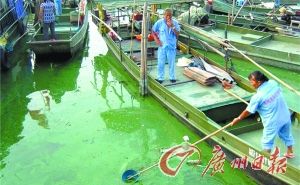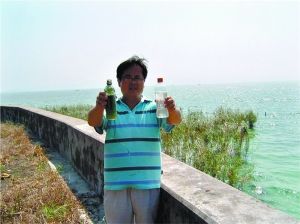
Blue-green algae appear on the Taihu Lake in 2010.

Taihu water (left) vs. clean water (right)
(Ecns.cn)--Taihu Lake, currently China's second largest freshwater lake, is slowly recovering from pollution, yet experts claim it will take "dozens of years" to fully clean up, reports the China Daily.
The latest statistics from the Bureau of Taihu Lake Basin show that the water quality of the Taihu has improved thanks to the diversion of freshwater from the Yangtze River.
Concentrations of permanganate, ammonia nitrogen, phosphorus and nitrogen—the water quality indexes—have decreased by 17 percent, 42 percent, 12 percent and 12 percent respectively from 2007 to 2011, the bureau says.
Blue-green algae, which normally appears on the lake in May or June, is now expected to form in August due to anti-pollution efforts, the Guangzhou Daily reports.
"The Taihu is actually quite beautiful in winter," says Wu Lihong, 45, a local resident who lives by the lake. "There is no algae from November until April or May every year."
However, Wu is well aware that the Taihu of today is a far cry from the idyllic natural spot that inspired the 1980s hit song "Taihu Beauty," which extolled the lake's "white sails above the water, green reeds along the water, and fish and shrimp below the water."
Algal blooms rarely struck back in those days, although the shallow lake—its deepest point is only three meters—is prone to eutrophication, or excessive nutrient buildup.
Long referred to as the "heart" of seven nearby cities, including Shanghai, Taihu Lake became the victim of heavy pollution as the regional economy started to take off in the 1980s.
Over the years, this major source of drinking water that straddles Zhejiang and Jiangsu provinces has been seriously polluted by sewage, as well as industrial and agricultural waste, which has encouraged the growth of algae. As a result, the lake has been choked, affecting drinking water supplies for millions of local residents, according to China Daily.
Huang Xuanwei, an engineer previously responsible for combating pollution at the lake, says that about 36 billion tons of sewage have been discharged into the Taihu every year since 1987.
"The Taihu's ecosystem began to shift from one dominated by diatoms, a benign kind of phytoplankton, to one in which cyanobacteria reign supreme. By the late 1990s, Microcystis blooms were a regular summer phenomenon," points out Richard Stone, who oversees Science Magazine's Asian news coverage and opened the magazine's Beijing bureau.
"I used to swim in the Taihu when I was little and the water was very clear," recalls Wu Lihong, "but now some of the water has already turned milky or even dark because of industrial waste."
As early as 1991, the central government had set out to rebalance the Taihu's ecosystem by launching a restoration project, and claims to have invested over 10 billion yuan since then to continue the clean-up process.
In 2005, the government started a second round of waste disposal at the Taihu. By then, 80 percent of its water area had been polluted, a massive increase from the 1 percent in 1991, according to Huang Xuanwei.
Two years later, a drinking water crisis in Wuxi of Jiangsu Province (which at the time got 80 percent of its drinking water from the lake) pushed the Taihu into the national spotlight. That May the algal mats were so thick, and the bloom so pervasive, that masses sunk to the bottom and rotted.
"Decaying algae has a very strong smell, like dead fish," Stone says, quoting Qin Boqiang, an ecologist at the Nanjing Institute of Geography and Limnology of the Chinese Academy of Sciences (NIGLAS).
Wuxi residents complained that their tap water stank, and Wuxi's waterworks couldn't cope with the sheer amount of putrid algae clogging its intake. Moreover, an attempt to flush the lake with water diverted from the Yangtze River backfired, forcing even more algae into the already overwhelmed system.
In response, local governments allotted 2 billion yuan to tackle the algae; a total of 2.8 million tons of it were removed from the lake from 2007 to 2011.
In addition, Wuxi's water intake pipe was moved just offshore, where prevailing winds tend to sweep the pea-green algal mats away and toward the center of the lake, says Stone, and "to wean itself off its Taihu dependency, Wuxi now pumps in half of its drinking water from the Yangtze River."
According to the Guangzhou Daily, around 20.2 billion cubic meters of water had been diverted from the Yangtze as of December 20, 2011.
However, restoring the Taihu to a truly healthy state poses a much greater challenge. "We would be lucky to solve the pollution problem within 30 years," laments Wu Lihong.
The challenges, Qin Baoqiang adds, will be to pinpoint the sources of nitrogen and phosphorous to better stem their flow into the lake.

Copyright ©1999-2011 Chinanews.com. All rights reserved.
Reproduction in whole or in part without permission is prohibited.